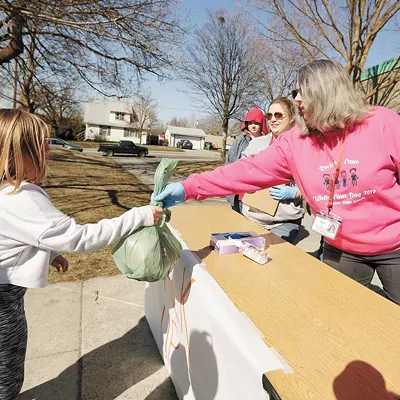
Since the coronavirus pandemic disrupted nearly every facet of daily life, several local food banks and pantries have seen demand for their services skyrocket.
With so many Inland Northwest residents still unable to return to work or facing serious economic pressures, the region's nutritional safety net is now bracing for what could be an even busier fall and winter.
The good news, however, is that leaders at some of the area's largest food banks and emergency meal providers say that even if demand increases to historically unseen levels, there's no concern that anyone will be turned away, even as distribution models are adapted to meet safety guidelines.
"I feel like we do have the capacity to continue for a long time," says Lisa Diffley, executive director of the Spokane-based Women and Children's Free Restaurant and Community Kitchen.
The nonprofit, located just north of downtown at 1408 N. Washington St., has been serving hot meals and providing essential groceries to local women and children in need since 1988. While on-site dining has been closed since March, clients are able to pick up ready-to-eat meals and pantry staples curbside each Tuesday and Wednesday from 11 am to 1 pm.
The nonprofit initially anticipated serving more than 100,000 meals this year, but since COVID-19 hit, it's far surpassed that goal, already serving more than 500,000, Diffley says. That includes meals made for the nonprofit's many community partners like YWCA Spokane, Transitions and Vanessa Behan.
"When I started to pivot to curbside services and working with homeless shelters and trying to get as many meals out as possible, I looked at this as [continuing for] a year," Diffley says. "I think the turnaround with unemployment is going to take a long time, and we are just bolstering and getting ready for whatever the community needs."
To prepare for that continued demand, Diffley had a second walk-in freezer installed to store extra food donations.
On a larger scale, Second Harvest, which distributes to 250 food pantries and partner meal sites across Eastern Washington and North Idaho including the Women and Children's Free Restaurant, distributed 11 million more pounds of food during its 2020 fiscal year ending in June than the prior fiscal period. That 37 percent increase from 2019 is all due to pandemic-caused need, says Second Harvest Chief of Staff Drew Meuer.
"In the pandemic environment, we've seen a sustained increase in the need for emergency food assistance, and we think that number will grow as fall and winter approach for a couple reasons," Meuer says.
Those factors, he says, include increased unemployment and the possible expiration of other benefits for rent and mortgage grace periods.
"We're expecting over the next six months, and preparing our operations, to very conservatively be 10 to 12 million pounds above our pre-pandemic level," of about 30 million pounds of food distributed per year, he says.
To reach those across the community in need, Second Harvest has both partnered with nonprofits on the neighborhood level, like immigration resettlement nonprofit World Relief Spokane, and through programs like its Mobile Food Market, which brings food directly to residents of underserved areas.
Launched at the onset of the pandemic, Spokane Food Fighters also worked closely with Second Harvest to deliver food directly to local residents in need. Spokane Food Fighters recently wrapped up this mission, which was always intended to be a temporary service.
"Our team has done a great job developing limited contact and contactless ways of getting food to people," Meuer says.
The widespread need for food assistance is also being profoundly felt by Spokane Valley Partners, a social services nonprofit that offers assistance beyond its food pantry, including a clothing bank, diaper bank and emergency utility bill assistance.
One of the nonprofit's focuses since the pandemic's onset has been getting food to local school-aged kids through its Food for Thought program. Through that endeavor, Spokane Valley Partners collaborates with the Central Valley School District to send bags of food home each Friday with students who might not have their nutrition needs fully met at home, says Angie Kelleher, the organization's development and communications director.
"Right when the pandemic started, we immediately saw a 40 percent increase" in the program, Kelleher says.
That's in addition to a 50 percent increase in new clients accessing Spokane Valley Partners' regular food pantry services since April.
Since the start of the upcoming distance-learning school year for Central Valley and other local school districts was delayed by several weeks, in turn affecting the district's summertime, school-sponsored free breakfast and lunch program, Spokane Valley Partners is also helping extend those three meal distribution sites.
To make sure students and their families have safe and easy access to those weekly free meals and the weekend meal bags, Spokane Valley Partners and the Central Valley School District began coordinating food drop-off routes using school buses, Kelleher says.
"That's why we're here," she says. "We want to remove barriers, we don't want someone to dig too hard to find us. We have the safety net and the whole thing has been engineered so we're there."
Along with children, another demographic uniquely impacted during the pandemic is local seniors on fixed incomes who rely on free meal sites and meal delivery services like those offered by Greater Spokane County (GSC) Meals on Wheels.
When COVID-19 hit, the countywide service immediately closed its 12 congregate meal sites, the Silver Cafe, says Jeff Edwards, executive director for GSC Meals on Wheels.
Closing the meal sites to keep high-risk seniors safe translated into an increase in those using Meals on Wheels' home delivery service.
"Over four weeks in April, we saw about a 22 to 25 percent increase in meals for home delivery, which took us from 16,000 to 21,000 meals a month, which is a pretty big increase," Edwards says.
Those drop-offs have also become contactless, with volunteers leaving food on clients' porches instead of entering their homes, a practice that normally serves as a wellness check for the mostly homebound seniors. Volunteers are still making visual contact with clients, Edwards says.
One new service GSC Meals on Wheels introduced since the pandemic's onset is called Diner's Choice, which provides seniors able to leave their homes with vouchers for meals at several area restaurants. After proving successful during a pilot this spring, the program partly funded by Aging and Long Term Care of Eastern Washington now serves 500 clients, Edwards says.
"These seniors can still get a meal and socialize and get out of the house," he says. "A lot of restaurants and staff have gotten to know the seniors, so it's been a good blessing to replicate that social experience we're designed to offer while making sure seniors are eating."
As demand for its services increases, GSC Meals on Wheels can always use more volunteer drivers to operate meal delivery routes around the county. Edwards says local businesses can easily sponsor a route by getting employees involved to deliver meals on a rotating basis; each route usually takes about an hour to complete.
He also emphasizes that GSC Meals on Wheels has the resources to add more clients to its roster.
"We want to let seniors know there isn't a waitlist. If someone calls today to sign up, we can get them started within 24 to 48 hours," he says. "We also want to encourage them to; they're not taking a meal from someone else" by using the service. ♦
HOW TO HELP
Find out how to support or request services from the nonprofits mentioned in this story:
Greater Spokane County Meals on Wheels: gscmealsonwheels.org, 924-6976
Women and Children's Free Restaurant and Community Kitchen: wcfrspokane.org, 324-1995
Spokane Valley Partners: svpart.org, 927-1153
Second Harvest: 2-harvest.org, 534-6678











































